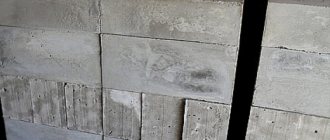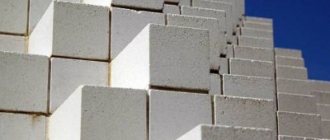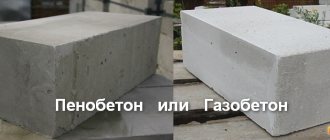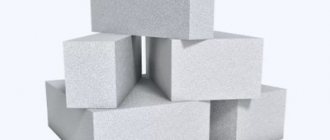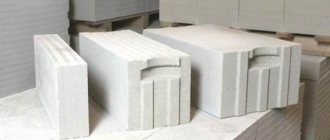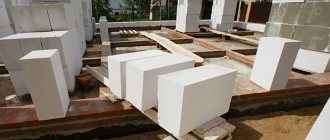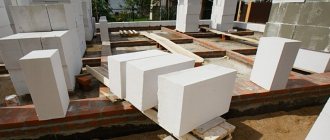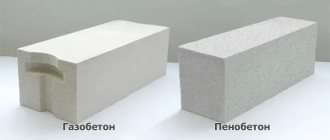In low-rise construction, large-format blocks are confidently replacing traditional brick and wood; most individual houses, dachas, and even bathhouses today are built from them. In the multi-storey construction segment, this process ended decades ago. Why? The answer is obvious: laying a building block is easier and faster, it costs less and has proven itself well in terms of consumer characteristics.
There are various types of blocks on the market - expanded clay concrete, gas silicate, aerated concrete, foam concrete, polystyrene concrete, slag concrete, ceramic... But experience shows: when preparing to build a country house, most people choose between foam block and gas block.
Fig.1 Masonry made of foam block and Twin block
"What is the difference?" - a question that always arises from the buyer. We decided to give a comprehensive answer to it and compared the foam block and Twinblock (trademark of aerated concrete block) according to key parameters.
Twinblocks
- Compound
- Classification
- Characteristics of twin blocks
- Advantages
- Flaws
- Areas of application
- Transportation methods
Twin block is a type of gas block, which is an environmentally friendly building masonry product, with high-precision geometry and tongue-and-groove elements, consisting of autoclaved cellular concrete.
Twinblock is a trademark; the product itself is produced using gas block technology GOST 31360-2007 with the addition of ash.
Twin block = gas block?
At its core, a twin block is the same gas block, but only with the addition of ash. This is an environmentally friendly masonry product with high-precision geometry. Thanks to tongue-and-groove slabs, laying walls with twin blocks does not cause difficulties and does not require adjustment. The twin block consists of autoclaved cellular concrete.
Twinblock is produced using gas block technology GOST 31360-2007 and is a trademark.
Twin block differs from gas block only in that it contains ash. The general composition of the twin block is as follows:
- ash (coal combustion product - ash waste);
Another difference between a twin block and a gas block is the size and grooves. Thanks to the ultra-precise geometry, the seam between the blocks is only 2-3 mm. This gives solidity to the walls, and the tongue-and-groove fastening makes this material convenient to work with.
Physical indicators:
Density
Hardness
Frost resistance
Thermal conductivity
Well, what can I say - one to one, copy to copy, among the manufacturers, in terms of physical indicators, there are no outsiders or leaders. Of course, the difference in frost resistance and hardness of individual blocks is striking, but feeling with our hands, driving dowels and other sharp things into the body of the gas blocks, we personally didn’t notice much of a difference...
Foam blocks
Foam blocks are a special building material, presented in the form of blocks consisting of the same foam concrete.
Attention: The only difference from twin blocks is the way the mass is divided into blocks. The twin blocks are cut using special strings, and the foam blocks are pre-filled into special molds.
Now foam blocks are gaining more and more popularity as one of the best building materials for cottages and low-rise buildings. It is growing so quickly that the existing production capacity of all companies is barely enough to cover the demand, which is growing and growing day by day.
Why are twin blocks popular?
The main reasons for its popularity are considered to be the following:
- Increase in construction of low-rise buildings;
- Excellent technical and operational characteristics of foam blocks;
Attention: The compressive strength of foam blocks is 3-5 MPa, which allows them to be used in the construction of buildings whose height can reach up to three floors and no more.
- The density of foam blocks, depending on the manufacturer and brand, is in the region of 400-1600 kg/m^3. This is two, and in some places even four times less than the density of another lightweight building material, expanded clay concrete, and almost the same as that of wood. This density simplifies the construction process of buildings and also reduces delivery and storage costs.
Let's take a look at the main indicators of this material.
| Low thermal conductivity | The thermal insulation characteristics of foam blocks are in no way inferior to the same wood and are three to four times superior to ordinary clay bricks. This allows a 20 cm thick foam block wall to retain heat in the building as well as a 60 cm brick wall. |
| High sound insulation properties | Foam blocks, thanks to the air contained in their cells, can provide excellent sound insulation. This factor is very important when constructing buildings in the city, where there is often a high level of street noise and which can be constantly annoying. |
| High moisture resistance | Most of the pores of foam blocks do not have contact with the external environment, which gives them high moisture resistance. Foam blocks made in accordance with GOST can float on the surface of the water for a week or more. |
| Low temperature resistance | A large number of cells filled with air allows water to migrate during freezing. Thanks to this, foam blocks do not lose their qualities even in the most severe frost. |
| Fire resistance | All components of foam blocks have a fire hazard rating of 1, which means that the foam blocks have high fire-resistant properties. Foam blocks are not capable of burning, and when heated they do not release toxic substances into the air. The blocks themselves can resist open flames for up to eight hours. |
| Homogeneous structure | Foam blocks, unlike building materials such as reinforced concrete and brick, which have special holes, have a completely homogeneous structure. This property allows you to process foam blocks in a variety of ways: drilling, |
Foam block
Foam block is a building material made from foam concrete. Consists of cement, sand and water with the addition of a foaming agent. It was invented in the 19th century. Then, due to the high cost of the components, it did not gain distribution. Widespread use began in the mid-20th century. Nowadays foam block is a common wall material. Belongs to the category of light cellular blocks. Produced according to GOST 25485-89 , GOST 5242-76 , GOST 21520-89 .
Specifications
The main physical and mechanical properties of foam blocks are:
- Standard size.
- Density.
- Thermal conductivity.
- Frost resistance.
- Production method.
Standard size. Foam blocks are produced in two sizes:
- Wall block. Size 600x200x300.
- Wall semi-block. Size 600x100x300.
Density. Based on density, foam blocks are divided into:
- Structural: grades D1000, D1100, D. They are used for the construction of building structures.
- Structural and thermal insulation: grades D500, D600, D700, D800, D. Used in the construction of partitions and walls of low-rise buildings.
- Thermal insulation. Brands D300, D350, D Serve for constructing a thermal insulation circuit for walls.
Frost resistance. For foam blocks it is equal to 15, 35, 50 and 75 cycles. Products with frost resistance of 75 cycles can be used in the northern zone.
According to the manufacturing method. Two methods are used in production:
- Cut block - a large slab of foam concrete is cut to specified dimensions on special machines.
- Molded block - foam concrete is poured into a mold with partitions. The cost of this method is lower.
Advantages and disadvantages of foam blocks. Scope of application
Advantages. Durability, strength, high fire safety, low water absorption, high frost resistance (up to 75 cycles), environmental friendliness, soundproofing, relatively low cost.
Flaws. Instability of geometric dimensions among different manufacturers, the need to finish the masonry surface to give an aesthetic appearance.
Scope of application: construction of load-bearing walls of low-rise buildings, installation of internal partitions and thermal insulation contours.
Why did Teplit choose ash?
First of all, because we care about the quality and environmental friendliness of our products. The background radiation of Twinblock is significantly lower than the maximum permissible norm specified in GOST standards. The fact is that when coal dust is burned, the non-combustible components of coal melt, and new minerals are formed, the radiation background of which is significantly lower than that of natural materials such as sand and clay. Thus, houses made from Twin Block are more environmentally friendly not only than houses made from aerated concrete (which contains quartz sand), but also houses made from brick and ceramic blocks. Our priority is to give the buyer the opportunity to build an environmentally friendly home!
Fact: the effective specific activity of NRN (natural radionuclides) of Twinblock is 56±28 Bq/kg (becquerel per kilogram). The properties of Twinblock are close to the properties of wood, it’s not for nothing that this material is called “mineral wood”!
In addition, research by technologists has shown that the use of fly ash helps:
- make the mixture more homogeneous;
— increase the frost resistance of building blocks;
- increase the strength of walls
Let us dwell in more detail on the last aspect – strength. It has been proven that the strength of the Twin Block is higher than that of a conventional gas block (at the same density): the strength of the D400 gas block is B2.5 (30-35 kg/cm2), the D500 Twin Block is B3.5 (39-41 kg/cm2). This is due to the fact that the activity of ash is higher than the activity of sand!
High strength allows you to construct buildings with load-bearing walls up to three floors and non-load-bearing walls in frame and frame-monolithic construction from Twinblock D400 without limiting the number of storeys!
Thus, if you want to build a strong and reliable house, choose Twinblock as your wall material!
From Ancient Rome to the Urals!
It would hardly be an exaggeration to say that in the field of construction we largely follow the ancient Romans, although technology has gone far ahead. Thus, modern aerated concrete is traditional Roman concrete, but with additives that make the structure of the material porous. After combining concrete with a gas generator, the material, like dough, rises and swells. Solid blocks are formed at the moment when concrete acquires minimum strength. Then they are baked in an autoclave. Autoclave processing can significantly improve the physical and chemical characteristics of Twinblock. Thanks to it, it is qualitatively superior to products such as foam blocks.
This is the general process of manufacturing modern building materials based on aerated concrete!
But let's get back to the ash. Some manufacturers add quartz sand to the blocks as an additive. We did not give preference to fly ash from the Reftinskaya State District Power Plant, the largest coal-fired thermal power plant in Russia. First, the coal is ground into dust, then burned in boilers at a very high temperature. The resulting ash does not contain toxic particles!
Advantages of using twin blocks
The advantages of using twin blocks include:
- A house made of twin blocks has a comfortable microclimate; in winter the walls retain heat well and in summer they never overheat. Energy savings for heating a house up to 30% compared to a brick house.
- Adhesive compositions are applied in a layer of 2-3 mm, the masonry is almost monolithic. There are no cold bridges.
- Neither the finished twin block nor its production technology involve any substances harmful to humans. The material is completely homogeneous. The radioactive background is low.
- The blocks are technologically advanced and processed with hand tools used for wood. Easy to cut, drill, and groove. You can hammer in nails.
Service life of houses made of different wall and building materials
| Material or technology | House life |
| Brick | 100 years |
| Log | 70-75 years |
| Rounded log | 50-60 years |
| Profiled timber | 50-55 years |
| Frame technology | 35-40 years |
| Twinblock | *at least 100 years |
*These are calculated data, since Twinblock is a new material! Houses built in the village of Reftinsky, Sverdlovsk region, without exterior finishing, have been standing for more than 30 years!
Advantages and disadvantages
If you plan to build a house from a twin block, then you need to find out about the pros and cons of the material in advance. Any owner wants their house to be beautiful, durable, reliable, so that its construction is as fast as possible. A structure made of twin blocks can meet all these requirements.
Advantages of twin blocks
Among their undeniable advantages:
- Environmental friendliness. Twin blocks are absolutely safe for humans. Despite the fact that lime is used for their production, it is no longer present in the finished product. Any aerated block is a synthesized stone; it does not even contain sand, but it retains the background radiation of the raw materials. This indicator for ash is significantly lower than for sand, which means that a house made of twin blocks will be even safer.
- High strength despite low specific gravity. The reason for this apparent discrepancy is the treatment with pressure and high temperature, the replacement of sand with more active ash. These operations significantly improve the properties of the new material - both its density and structure.
- Low thermal conductivity. It makes it possible to maintain a favorable indoor microclimate even in the most severe frosts; in the summer heat the house will also be comfortable. However, this plus applies to all cellular concrete.
- Relative ease of processing. The material is quite easy to cut even with an ordinary hacksaw; drilling holes also does not take much time and effort. This practicality allows the construction of buildings of the most complex configuration.
- High degree of sound insulation. Aerated concrete also owes these properties to its original porous structure: a large number of cells filled with air.
- Ideal geometry. As already noted, the seams are almost invisible, and a minimum amount of cement-based glue is required for their installation.
- Fire resistance and frost resistance. Aerated concrete is a non-flammable material, and its porous structure guarantees protection from the cold even in the northern regions of the country.
- Significant savings. Walls made of lightweight material do not require a massive, super-reliable foundation, so the cost of concrete and reinforcement is significantly reduced.
- Low shrinkage of twin block masonry. It is a guarantee of the integrity of any finishing layer.
Adhesive composition for reliable twin block laying
As already mentioned, when laying twin blocks, glue is used rather than cement-sand mortar. the KTB adhesive from. The glue is produced in the form of a dry mixture, packaged in 25 kilogram bags.
Before use, the dry substance is filled with water in a ratio of 280 grams per 1 kg of mixture . The composition is mixed for a minute to obtain the optimal consistency. The viability of the solution after preparation is 30 minutes.
Work is carried out at air temperatures above +5 degrees Celsius. The finished composition is applied to the prepared base, cleaned of dirt, dust and snow.
Consumption rate
With a layer thickness of 1 mm, about 1.5 kg of glue . Note that the maximum permissible layer thickness can reach 5 mm , and accordingly the consumption will increase.
Builder tips
Craftsmen claim that a facility can be built quickly from aerated concrete material, and the cost is considered acceptable compared to other analogues. With a reliable foundation and correctly selected wall thickness, a comfortable microclimate will be maintained inside the premises. But at the same time, it is necessary to carefully seal all the cracks in the masonry joints.
If you leave unfinished construction for the autumn-winter season, the object will have to be preserved so that the blocks do not absorb a lot of moisture.
Today, experienced experts recommend using a twin block. The material managed to gain popularity, taking a leading position in the construction industry. True, its cost is higher than that of a gas block, but this drawback is justified by the quality of the object.

